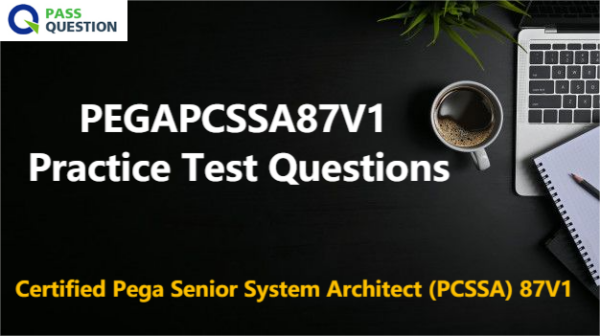PEGAPCSSA87V1 Practice Test Questions - Certified Pega Senior System Architect (PCSSA) 87V1
Looking for an easy way for clearing the PEGAPCSSA87V1 Certified Pega Senior System Architect (PCSSA) 87V1 exam? You can get the latest PEGAPCSSA87V1 Practice Test Questions from PassQuestion that provide all the important features to clear the Pegasystems PEGAPCSSA87V1 Exam. The PEGAPCSSA87V1 actual questions and answers are prepared by the experts that are relevant and according to the requirement of the PEGAPCSSA87V1 exam. Make sure you choose the latest PEGAPCSSA87V1 Practice Test Questions to study multiple times and it will definitely help you pass the Certified Pega Senior System Architect (PCSSA) 87V1 PEGAPCSSA87V1 exam.

PEGAPCSSA87V1 Exam Overview - Certified Pega Senior System Architect (PCSSA) 87V1
The Certified Pega Senior System Architect version 8.7 certification validates the ability to use Pega to design and build for reusability across multiple lines of business, and includes applying best practices, understanding application debugging, understanding performance tuning and system maintenance techniques, and addressing security/access requirements in an application. The version 8.7 exam includes scenario questions, multiple choice questions and drag/drop items.
PCSSA Version 8.7 Exam Information
Exam Code: PEGAPCSSA87V1
Type of Exam: 60-question exam
Length: 90 minutes
Passing Grade: 70%
Language: English
Prerequisites: Senior System Architect
PCSSA Version 8.7 Exam Objectives
Application Development (28%)
- Define the Enterprise Class Structure
- Create an application with the New Application wizard
- Understand the rule resolution process; adjust rule availability
- Identify how circumstancing affects application behavior
- Circumstance rules on a single variable or multiple variables
- Differentiate between a queue processor and a job scheduler
- Identify the role and elements of activities in case processing
- Automate actions when a property value changes
- Promote rule reuse with relevant records
- Identify the role and impacts of application versioning; Use of ruleset skimming
- Configure and validate application rulesets
- Branch rulesets for parallel development
- Migrate an application; use of product rules
Case Management (15%)
- Differentiate between work groups, work queues, and organizational structures
- Configure parallel processing for cases
- Manage concurrent case access; locking strategies
- Configure flow action pre- and post- processing
- Extend service-level agreement configurations
Data and Integration (19%)
- Validate data against a pattern
- Identify use cases for keyed data pages
- Exchange data with other applications
- Manage integration settings
- Address integration errors in connectors
- Expose an application with a web service
User Experience (5%)
- Create and customize Pega Web Mashups
- Configure Pega Web Mashup authentication
Reporting (5%)
- Design reports with multiple sources; associations and joins
Performance (7%)
- Measure System Performance; use of performance-related tools
- Debug system performance
- Review log files: Distinguish system events and performance events
Security (16%)
- Distinguish between role-based, attribute-based, and client-based access control
- Organize and manage case attachments
- Secure data with data encryption
Mobility (5%)
- Differentiate between the delivery options for mobile devices
- Design applications for mobile use; use of certificate sets
View Online PCSSA Version 8.7 PEGAPCSSA87V1 Free Questions
1.A report needs to list the user ID of the manager of the operator who creates a time-off case. The report provides information from the MyCo-HR-SelfService-Work-TimeOff and Data-Admin-Operator-ID classes.
Which two options independently satisfy the business outcome? (Choose Two)
A. Add the operator ID to the report definition as a parameter.
B. Configure a class join on the report definition to join operator information to each case.
C. Use an association rule to join operator information to each case.
D. Specify both classes in the Pages & Classes tab on the report definition.
Answer: BC
2.Which two data elements can be used as an attribute for an access control policy? (Choose Two)
A. Appointment date
B. Encrypted bank account number
C. Number of dependents
D. Password string
Answer: B
3.When designing reports with multiple data sources, in which two ways is an association rule different from a class join? (Choose Two)
A. A class join is required to add a filter condition to your report.
B. Anyone with the appropriate permissions can use associations when creating reports in the User portal.
C. Class joins are unique to each report. Associations are reusable in any report.
D. You can join multiple classes with class joins, while you cannot join multiple classes with associations.
Answer: BC
4.What is the difference between using the Call and Branch methods in an activity step to invoke other activities?
A. Call returns to the originating activity, while Branch skips the remainder of the originating activity.
B. Branch overrides the security restrictions of the called activity allowing you to easily test code; it will not run in production
C. Call provides more robust debugging capability than Branch, while Branch provides better run-time performance.
D. Branch creates a new thread to allow asynchronous processing, while Call runs in the thread from it was invoked.
Answer: A
5.Which two best practices for creating a mobile app on Pega Platform guarantee a consistent user experience? (Choose Two)
A. Apply both responsive and adaptive user interface designs to optimize the display of the app.
B. Incorporate Android emulators during the development and production phases.
C. Use multiple unlocked rulesets when developing a mobile app.
D. Decide early in the development process if the mobile app supports offline mode.
Answer: AD
6.In MLP2, the business asks you to create a mobile app for an existing Pega Platform application.
Which two of the following actions are required to create the mobile app? (Choose Two)
A. Set up push notifications for developers.
B. Configure the mobile application access in Dev Studio.
C. Configure access to the Pega Mobile Build Server.
D. Create a certificate set.
Answer: CD
- TOP 50 Exam Questions
-
Exam
All copyrights reserved 2025 PassQuestion NETWORK CO.,LIMITED. All Rights Reserved.

